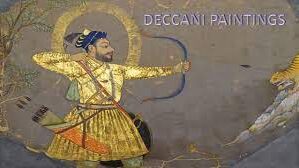
A Journey through the Artistic Splendour
Introduction
The art of miniature painting has fascinated art enthusiasts and collectors for centuries. Among the various schools of miniature painting, the The art of miniature painting has fascinated art enthusiasts and collectors for centuries. Among the various schools of miniature painting, the Decan Miniature Painting stands out as a testament to the rich artistic heritage of the Deccan region in India. stands out as a testament to the rich artistic heritage of the Deccan region in India. This unique form of painting flourished during the 16th to 19th centuries and captured the imagination of both artists and connoisseurs with its intricate details, vibrant colors, and cultural motifs.
In this post, we will embark on a journey through the captivating history of Decan Miniature Painting. From its origins to its development and influence, we will explore the key aspects that make this art form so remarkable. Let’s delve into the world of Decan Miniature Painting and unravel its hidden treasures.
I. Origins and Influences
Decan Miniature Painting finds its roots in the rich artistic traditions of the Deccan plateau in South India. The Deccan region was known for its cosmopolitan culture, vibrant courts, and patronage of the arts, which laid a fertile ground for the growth of miniature painting. The art form drew influences from various sources, including Persian, Mughal, and indigenous styles, resulting in a distinct and captivating aesthetic.
II. Development and Styles
As Decan Miniature Painting evolved, it developed its unique styles and characteristics. The artists of the Deccan region experimented with different techniques, color palettes, and themes, creating a diverse range of styles within the genre. This section will explore prominent Decan miniature painting styles, such as the Bijapur, Golconda, and Hyderabad schools, highlighting their distinctive features and contributions to the art form.
III. Themes and Motifs
Decan Miniature Painting encompassed a wide range of themes and motifs, providing a window into the socio-cultural fabric of the Deccan region. From illustrations of courtly life, portraits of rulers, and depictions of mythical and literary tales to religious and mystical subjects, the artwork reflected the multi-layered narrative of the era. This section will delve into the fascinating themes and motifs found in Decan Miniature Painting, shedding light on the stories they convey and the symbolism they hold.
IV. Techniques and Materials
The mastery of techniques and the skillful use of materials were integral to the creation of Decan Miniature Painting. This section will explore the tools and materials employed by the artists, such as brushes made from squirrel hair, pigments derived from minerals and organic sources, and delicate handmade paper. We will also delve into the meticulous techniques employed, such as fine brushwork, stippling, and the application of gold leaf, which added depth and richness to the artwork.
V. Legacy and Revival
The decline of Decan Miniature Painting came with the shifting political landscapes and changing patronage during the colonial era. However, the art form experienced a revival in the modern era, with efforts to preserve and revive the traditional techniques and motifs. This section will explore the legacy of Decan Miniature Painting, its impact on subsequent art movements, and the ongoing endeavors to keep the art form alive through exhibitions, workshops, and academic research.
Conclusion
Decan Miniature Painting stands as a testament to the artistic brilliance and cultural heritage of the Deccan region. Its intricate details, vibrant colors, and diverse themes continue to captivate art enthusiasts and collectors around the world. By delving into its origins, styles, techniques, and motifs, we have gained a deeper understanding and appreciation of this unique art form. As we celebrate the legacy of Decan Miniature Painting and its revival in the modern era, let us recognize the invaluable contribution it has made to the artistic tapestry of India and the world.